Building AAC Facilitation Skills with Tabi Jones-Wohleber: MASTER PAL Training, Module 6
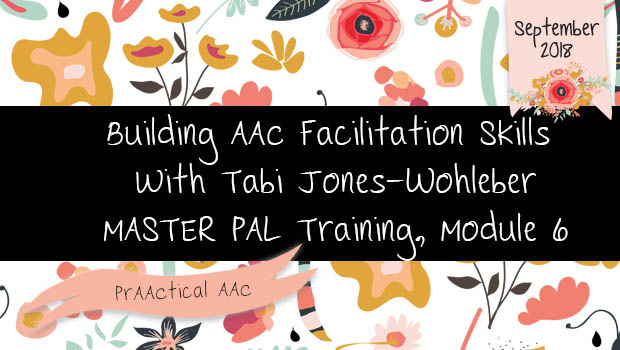
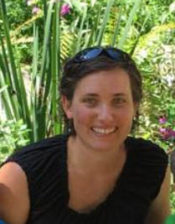 Let’s be honest: The most advanced AAC device in the world isn’t going to be very helpful unless it’s well-implemented. That’s why it is so important that communication partners, particularly those who spend lots of time with people use AAC, get training on ways to support the AAC learner. Tabi Wohleber-Jones is back with us today to share the 6th module in the MASTER PAL series. This module is all about time.
Let’s be honest: The most advanced AAC device in the world isn’t going to be very helpful unless it’s well-implemented. That’s why it is so important that communication partners, particularly those who spend lots of time with people use AAC, get training on ways to support the AAC learner. Tabi Wohleber-Jones is back with us today to share the 6th module in the MASTER PAL series. This module is all about time.
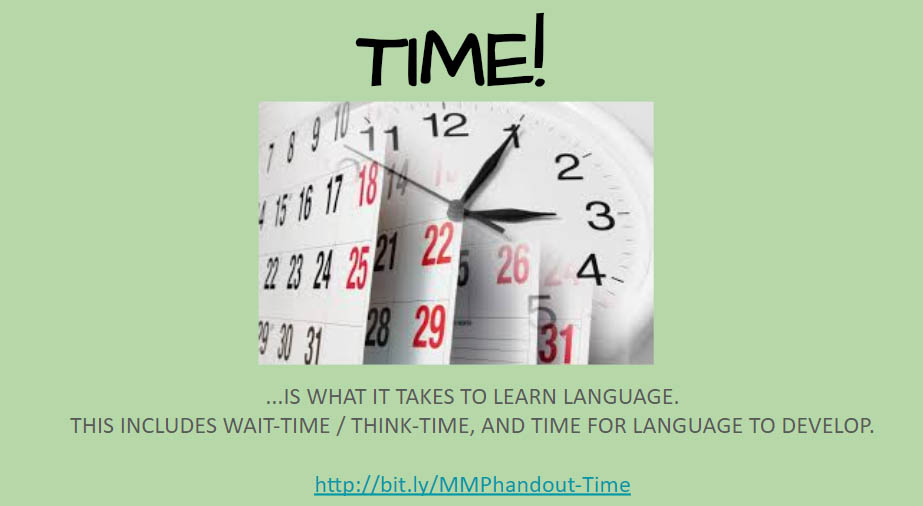
Model as a MASTER PAL
Module 6: Time: Wait-Time, Think-Time and Time for Language to Develop
Facilitator Guidelines
This 6th module in Model as a MASTER PAL explores both short-term and long-term factors related to time, as necessary for AAC skill development. These modules may be explored in a single learning session or split into two sessions, 20-30 minutes each.
Firstly, language development occurs gradually over time, years actually. Teaching language with AAC takes time as well. Putting a communication system in place is the first step. Giving time and support to teach language is the long-game.
In the short-term, wait time is an essential strategy to foster understanding, learning and autonomous interactions. Put differently, wait time is “think time”. It is not empty space. This module engages participants in activities and discussion that highlight the relevance quiet pauses to maximize the meaningfulness of the interaction.
For this module, you will need:
Warm-up Discussion
| Thinking Prompt | Making Connections / Talking Points |
| Slide 10:
LANGUAGE DEVELOPMENT Think of a young child (0-5 years) in your life, past or present.
|
Establishing what typical language development looks like is a useful perspective for discussing the role of the communication partner in supporting AAC users.
|
| Slide 20-24:
THINK-TIME…aka wait-time Hink Pink activity |
Slide 20 – Introduction to Hink Pinks. Provide participants with something to write with, and give them a moment to process the example. Tell them “I am going to show you 5 hink pinks. You will have 30 seconds to record your responses. This is an individual activity NOT a group activity”
Slide 21 – This is an animated slide. The hink pinks appear on the left. When you press enter or space, the answers appear on the right. Show only the left column to start. Time 30 seconds. Instruct participants to put down their pencils. Survey the room…how many finished? How many even got started? Show the answers. Slide 22 – This is an animated slide to help participants label and describe their experience. Invite participants to raise their hand or discuss their experience of being rushed, per the examples, as well as share their own thoughts. Slide 23 – This is another animated slide with different hink pinks. This time there is no time limit. Let participants work until they feel finished (even if they don’t get all the answers). Show answers. Slide 24 – This is an animated slide to help participants label and describe their experience. Invite participants to raise their hand or discuss their experience of being given the time they need to process the task and try their best, per the examples, as well as share their own thoughts. How does this relate to the wait-time needed by our students who use AAC? |
The Discourse
| Topics Addressed | Slide(s) | Talking Points / Examples |
| Title Slides | 1-2 | N/A |
| Communication Review | 3-7 | Review of Model as a MASTER PAL and AAC to ensure all participants are on the same page |
| Introduction & Warm-up Discussion (Language Development) | 8-10 | Explained on Slides.
See chart above for Warm-up Discussion. |
| Language Development:
Acquired in a relatively predictable fashion |
11 | The predictable progression of language development applies to children who are typically developing as well as those who acquire language with an AAC system. A child does not formulate novel sentences before learning to communicate for a variety of purposes. Growth in the areas listed gives us a basic understanding of the language development progression.
The last statement is animated; modeling (in the child’s communicative modality) shapes the language learned. |
| Language Development:
Evolution of words & phrases |
12-13 | Slide 12-This is an animated slide that illustrates the emergence of first words and phrases and how they morph into well-formed sentences and ideas.
Slide 13 – Summary statements related to the emergence of language. |
| Language Development:
Babbling |
14 | This is an animated slide. The functions of babbling as a developmental language behavior are described at the top. The functions of babbling for a child learning AAC are described at the bottom. The example should be modeled aloud (with enthusiasm). |
| Language Development:
Self-Talk |
15 | This is an animated slide. The functions of self-talk as a developmental language behavior are described at the top. Self-talk is mostly internalized by about age 5 or 6, but will sometimes occur after that when kids are processing new concepts. By 5, kids are effective users of language. If relevant, share or invite participants to share about whether they have noted or remember self-talk in young children in their life. Most of us can recall the “noisy” play of a 3-year-old playing solo while chattering away.
The functions of self-talk for a child learning AAC are described at the bottom. |
| Language Development:
Repetition |
16 | This is an animated slide. The functions of repetition as a developmental language behavior are described at the top. Repetition of phrases and sentences is often observed as children begin to gain some command of their communication skills, either receptively or expressively. The functions of repetition for a child learning AAC are described at the bottom. |
| Language Development:
When it’s disruptive |
17-19 | Strategies for putting oneself in a respectful mindset when communication behaviors are disruptive, & justification for why it is imperative to honor a child’s communication tool as his voice.
Slide 18– Examples of management strategies, when slide 17 examples aren’t enough
|
| Introduction & Warm-up Discussion | 20-24 | Explained on Slides.
See chart above for Warm-up Discussion |
| Introduce wait-time as think-time | 25 | Brief overview of the study, linked in Supplemental Handouts: http://bit.ly/ThinkTime
Brief video spells out similar points made in the article. https://www.youtube.com/watch?v=sCLRrmeLk6A In summary, all aspects of interactions (teacher and student interactions and learning opportunities), improve when extended wait-time is provided. Consider having the group sit in silence while you count silently to three. Indicate aloud when you stop and start. Three seconds actually feels long when no one is speaking. Discuss with the group how long they wait for a response from a specific student. Is there an awareness of the amount of wait-time a specific student requires…10 sec, 20 sec, 60 sec. How long do we actually give? wait-time is hard, but essential |
| Why think-time is necessary | 26-27 | Explained on Slides.
Slide 26 Video: It takes the student more than 30 seconds to indicate a response. Note that the response was incorrect, but validated by the teacher and the correct response modeled. Also, the student was not interrupted during the time it took for him to respond. It appears all of the components addressed on this slide may have influenced the amount of wait-time this student required to formulate a response. Invite participants to share their strategies for providing wait-time in the midst of attempting to provide rigorous instruction. The support of paraprofessionals is critical here. The more invested they are in instruction, the more individualized instruction is able to be provided simultaneously. |
| Let’s Re-Cap | 28 |
|
Supplemental Handouts: Wait-Time as Think-Time
Video Links
Interactive Activities/Discussions
- Hink Pinks, as a warm-up activity
- Wait it Out: Demonstrate how long 3, 5, 15, 30 or 60 seconds is by waiting in silence for a variety of durations.
Extension Resources
- AAC Language Lab
- Language Stages
- Resources→ Language Reference Charts (requires subscription)
Filed under: Featured Posts, PrAACtical Thinking
Tagged With: AAC partner training
This post was written by Carole Zangari

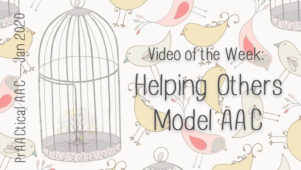
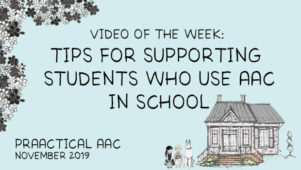
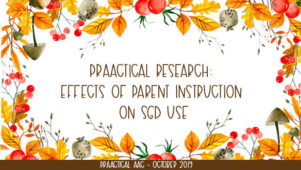
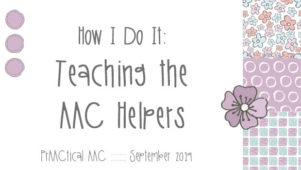
2 Comments
These series has been invaluable! Thank you so much for sharing!
I’m thrilled you find it useful. The nuances of partner interactions are so important in effective implementation of AAC, yet often overlooked.